
The Knappenrode energy museum is a museum in Hoyerswerda, Saxony Germany. The museum is an Anchor point on the European Route of Industrial Heritage. [1]

The Knappenrode energy museum is a museum in Hoyerswerda, Saxony Germany. The museum is an Anchor point on the European Route of Industrial Heritage. [1]
Knappenrode is a monument to brown coal. Around 1914 the natural landscape of heathland and coniferous forest was replaced by this vast open cast brown coal mining operation and briquetting plants. The workers dwelt in a specially-erected housing outside the factory gates. This was a true factory village- the company owned the houses, the store, a guest house, a community centre and a railway station. It provided the village with a company owned cemetery. The workers and families used the factory bathhouse so the houses needed no bathrooms. When retired, they came back and used the bathhouse on Saturday nights. [1]
A briquetting plant, the "Eintracht Werke," was built in 1914. It was managed by Joseph Werminghoff. Production began in October 1918, and two other plants were then built. After 1945 the plant was renamed "Glückauf", some equipment removed and production continued. In 1965 the plant turned out more than one and a half million tons of briquettes. Modernisation was neglected and the plant stagnated and closed in 1993, leaving a legacy of historic machines that form the nucleus of a museum collection. [1]

The Ruhr, also referred to as the Ruhr area, sometimes Ruhr district, Ruhr region, or Ruhr valley, is a polycentric urban area in North Rhine-Westphalia, Germany. With a population density of 1,160/km2 and a population of over 5 million (2017), it is the largest urban area in Germany and the third of the European Union. It consists of several large cities bordered by the rivers Ruhr to the south, Rhine to the west, and Lippe to the north. In the southwest it borders the Bergisches Land. It is considered part of the larger Rhine-Ruhr metropolitan region of more than 10 million people, which is the third largest in Western Europe, behind only London and Paris.
Bord na Móna is a semi-state company in Ireland, created in 1946 by the Turf Development Act 1946. The company began developing the peatlands of Ireland with the aim to provide economic benefit for Irish Midland communities and achieve security of energy supply for the recently formed Irish Republic. The development of peatlands involved the mechanised harvesting of peat, which took place primarily in the Midlands of Ireland.
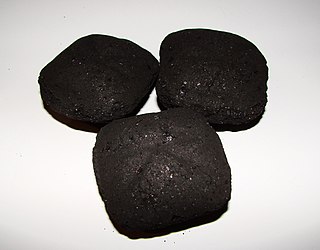
A briquette is a compressed block of coal dust or other combustible biomass material used for fuel and kindling to start a fire. The term is a diminutive derived from the French word brique, meaning brick.

A company town is a place where all or most of the stores and housing in the town are owned by the same company that is also the main employer. Company towns are often planned with a suite of amenities such as stores, houses of worship, schools, markets, and recreation facilities.

Pernik is a town in western Bulgaria with a population of 70,285 as of 2021. Pernik is the most populated town in western Bulgaria after Sofia. It is the main town of Pernik Province and lies on both banks of the Struma River in the Pernik Valley between the Golo Bardo Mountain, Vitosha Mountain, Lyulin and Viskyar mountains. Pernik is the principal town of Pernik Province – a province in western Bulgaria, which is next to the Serbian border.

The Yallourn Power Station, now owned by EnergyAustralia a wholly owned subsidiary of the Hong-Kong–based CLP Group, is located in the Latrobe Valley of Victoria, Australia, beside the Latrobe River. Yallourn PS was a complex of six brown coal–fired thermal power stations built progressively from the 1920s to the 1960s; all except one have now been decommissioned. Today, only the 1,450 megawatts (1,940,000 hp) Yallourn W plant remains. It is the second largest power station in Victoria, supplying 22% of Victoria's electricity and 8% of the National Electricity Market. The adjacent open cut brown coal mine is the largest open cut coal mine in Australia, with reserves sufficient to meet the projected needs of the power station to 2028. On 10 March 2021, EnergyAustralia announced that it will close the Yallourn Power Station in mid-2028, four years ahead of schedule, and instead build a 350 megawatt battery in the Latrobe Valley by the end of 2026. At the time, Yallourn produced about 20% of Victoria's electricity.
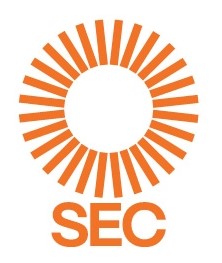
The State Electricity Commission of Victoria is a government-owned electricity company in Victoria, Australia. Originally established to generate electricity from the state's reserves of brown coal, the SEC gradually monopolised most aspects of the Victorian electricity industry, before being broken up and largely privatised in the 1990s. After several decades of dormancy, it was revived in 2023 to invest in renewable energy and storage markets.

The Energy Brix Power Station was a brown coal–fired thermal power station located at Morwell, in Victoria, Australia. The power station was used to supply electricity for the retail market, as well as the production of briquettes in the adjacent Energy Brix briquette works. It was shut down in August 2014 and is currently the earliest surviving large-scale power station designed to provide electricity to the state electricity network.

Plessa is a municipality in the Elbe-Elster district, in Brandenburg, Germany.
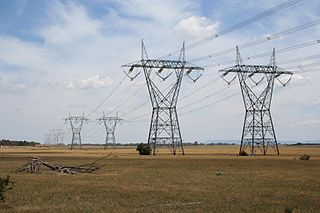
Energy in Victoria, Australia is generated using a number of fuels or technologies, including coal, natural gas and renewable energy sources. Brown coal, historically, was the main primary energy source for the generation of electricity in the state, accounting for about 85% of electricity generation in 2008. The amount of coal-fired power has decreased significantly with the closure in 2017 of the Hazelwood Power Station which supplied around 20% of Victoria's electricity, and to a lesser extent with the exit of Anglesea Power Station in 2015. Brown coal is one of the largest contributors to Australia's total domestic greenhouse gas emissions and a source of controversy for the country. Australia is one of the highest polluters of greenhouse gas per capita in the world.

The Zollverein Coal Mine Industrial Complex is a large former industrial site in the city of Essen, North Rhine-Westphalia, Germany. The first coal mine on the premises was founded in 1847, and mining activities took place from 1851 until December 23, 1986. For decades, starting in the late 1950s, the two parts of the site, Zollverein Coal Mine and Zollverein Coking Plant, ranked among the largest of their kinds in Europe. Shaft 12, built in the New Objectivity style, was opened in 1932 and is considered an architectural and technical masterpiece, earning it a reputation as the "most beautiful coal mine in the world".
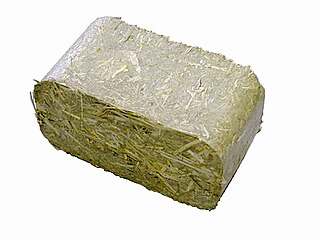
Biomass briquettes are a biofuel substitute made of biodegradable green waste with lower emissions of greenhouses gases and carbon dioxide than traditional fuel sources. This fuel source is used as an alternative for harmful biofuels. Briquettes are used for heating, cooking fuel, and electricity generation usually in developing countries that do not have access to more modern fuel sources. Biomass briquettes have become popular in developed countries due to the accessibility, and eco-friendly impact. The briquettes can be used in the developed countries for producing electricity from steam power by heating water in boilers.
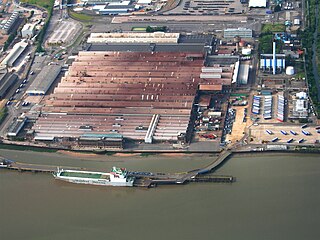
Ford Dagenham is a major automotive factory located in Dagenham, London, operated by the Ford of Britain subsidiary of Ford Motor Company. The plant opened in 1931 and has produced 10,980,368 cars and more than 39,000,000 engines in its history. It covers around 475 acres and has received over £800 million of capital investment since 2000.

The Tejo Power Station was a thermoelectric power plant owned by the Companhias Reunidas de Gás e Electricidade, which supplied power to the city and entire Lisbon region.

The Bata shoe factory in East Tilbury is what remains of an industrial estate in Essex, England, which produced shoes for over 70 years. Founded in 1932 by Tomáš Baťa, the factory was "one of the most important planned landscapes in the East of England" in the 20th century. The factory closed in 2005.
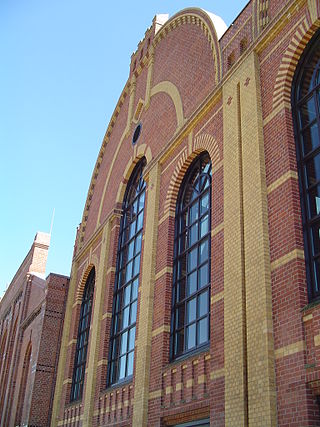
The Saxon Museum of Industry is a museum with four locations in Saxony. It is organised as a "special purpose association", the members of which are the towns of Chemnitz, Crimmitschau, Ehrenfriedersdorf and Hoyerswerda.

The Muzeum Fabryki, is a museum in Łódź, Poland. The museum is an Anchor point on the European Route of Industrial Heritage.

The Museum of Industry, Work and Textiles is a museum in Ghent in Belgium. Ghent was at the centre of the Flanders textile region. The museum is an Anchor point on the European Route of Industrial Heritage.

The Meuro mine was a former open-cast mine located in the state of Brandenburg, Germany that was in operation from 1958 to 1999. It was a source of lignite, often referred to as brown coal, which was used in local factories and power stations. It was one of a number of mines in the Lusatia area which left a massive water debt when the water was pumped out for the operation of the mine. This had to be remediated by the company, Lausitzer und Mitteldeutsche Bergbau-Verwaltungsgesellschaft (LMBV), a state-owned company. The area was flooded and converted into a multi-use recreation and tourism area.

The Rheinisches Braunkohlerevier, often called the Rhenish mining area, is a lignite mining area or district in the Cologne Bay, on the northwestern edge of the Rhenish Slate Mountains. The mining of lignite using the open pit method has had a significant impact on the landscape here and led to the formation of several important industrial sites. The area includes the Zülpicher and Jülicher Börde, the Erft lowlands and the Ville, making it the largest lignite mining area in Europe. To a lesser extent clay, silica sand and loess are mined here. The area is the only active lignite mining area in what was West Germany during German partition and contains the mines with the largest surface area, greatest depth, and biggest annual output of coal.